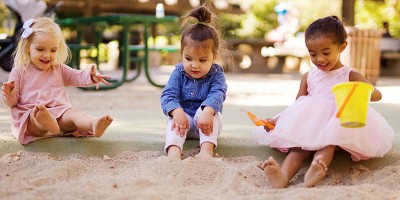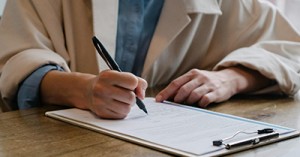When children move into early childhood settings they broaden their experiences as participants in different relationships and communities. When educators create environments in which children experience mutually enjoyable, caring and respectful relationships with people and the environment, children respond accordingly. The following article provides activities to promote each of the sub outcomes of EYLF Outcome 2: Children Are Connected With And Contribute To Their World.
Activities To Promote EYLF Outcome 2
- 2.1 Children develop a sense of belonging to groups and communities and an understanding of the reciprocal rights and responsibilities necessary for active community participation
One of the most enjoyable ways that educators can achieve this Learning Outcome is by helping children recognise and build connections between the early childhood setting and the local community. For example, when fostering positive eating practices in children, see if you can plan excursions to the neighbourhood farmer’s market or visit a local organic vegetable farm. Once back in the centre, build on those experiences by planning for activities related to healthy eating. So, during art time, have children use vibrant coloured fruits and veggies as still life models and then have fun making a salad out of those or get them to grow their own vegetable patch or a herb garden.
Yet another constructive way that educators can help children broaden their understanding of the world in which they live is through lessons like road safety education. Invite members of the traffic police force or your local fire-fighting unit to give a talk on road safety to children. Once children have been told about road safety rules – like how to cross a road, different traffic lights and their meanings, how to be safe around bikes – use art or craft times to help them to engage with such ideas. Get them to decide on a couple of themes and then have groups working to create posters or dioramas. Use their creations to open up and extend discussions like how to protect pets on roads or what to watch out for when being driven around in a car.
- 2.2 Children respond to diversity with respect
In the journey to meet this Learning Outcome, one of the best starting points for educators is reflecting on their own responses to diversity. For example, if the service has a few families who identify as Aboriginal, educators can discuss different levels of understanding of Aboriginal culture among the staff before brainstorming on how to increase their cultural competence. This can be done by acquiring books and resources so that all staff have an introduction to Indigenous Australia and eventually by inviting Aboriginal families to come in and chat about their culture and discuss what they feel is important for educators to teach children and how.
One of the most effective ways that educators can meet this learning outcome element is by planning for more representative resources that broaden children’s perspectives and encourage appreciation of diversity. For example, In the classroom, ensure that posters, artworks, charts and other wall displays include figures with diverse skin colours, abilities and professions; similarly equip craft and play areas with toys, books, dolls, stickers and puppets from a variety of races and ethnicities. Plan lessons with stories, songs, poems and rhymes from different cultures and create positive associations with darker colours by using stories like Black Beauty; In the classroom, use maps of Aboriginal Australia and colonial Australia to open discussions on how countries and societies change over time.
Yet another way that educators and services can implement this learning outcome element is by exploring the culture, heritage, background and traditions of each child within the context of their community – and one of the most enjoyable ways to make this happen is through celebrations. Get children involved when marking celebrations in the school cultural calendar to enhance their sense of belonging in culture and community. Use art and craft time to encourage them to make decorations or paint in colours that are an intrinsic part of celebrations in their culture. Another important way to build agency in children is to invite them to share which personal or family milestones they would like to celebrate, like getting a new pet, riding a bike or a grandparent coming to visit.
- 2.3 Children become aware of fairness
Meeting this learning outcome involves educators talking about differences in a healthy way. So the next time, when a child asks about or comments on why particular child talks in a “funny” way or eats “smelly food”, instead of changing the subject or ignoring such questions, use age-appropriate language to explain that people may look, talk and eat differently but such differences make the world a richer place. Also investigate, without a non-blaming approach, why the child may be asking questions or making comments about differences. Though educators are not expected to be experts on all matters, just see that you give out the correct information. If you don’t know the answer to a question, then invite the children to find out more together or lookup resources on dresses, cuisines and practices of different cultures.
Another way that educators can implement this learning outcome is by engaging children in discussions about respectful and fair interactions. For example, children may be equipped with the social and emotional skills to recognise examples of bullying behaviour, like when a child dominates the use of resources or calls others hurtful names. Additionally, children can be taught words and phrases like “Leave me/him/her alone” or “back off” that are simple, direct but non-antagonistic since a put-down can aggravate a bully even further. Kids can also use social strategies like a buddy system to discourage bullies.
For older children, educators can analyse and discuss with children ways in which texts construct a limited range of identities and reinforce stereotypes. One way this can be done by using stories and popular culture to discuss how girls and women are largely placed in domestic settings, followed by a comparison with real-life women leaders and professionals from different walks of life.
- 2.4 Children become socially responsible and show respect for the environment
Among the most engaging ways that educators can implement this Learning, Outcome is by providing children with access to a range of natural materials in their environment. Some ideas are leaves, nuts, bark, sticks and pebbles that can be incorporated in art activities or pine cones and sticks added to blocks. Encourage children to play with natural elements like water, sand, and clay and also provide logs for balancing, climbing and sitting. Play with natural materials not only helps children connect with and care for nature but also supports sensory and cognitive learning.
Yet another way that educators can meet this Learning Outcome is by opening discussions on the impact of human activities on environments through information sharing and activities. For example, on your next neighbourhood walk or school trip, tell children to look for a problem in the environment. Once you return to the classroom, ask them about what they have noticed like perhaps littering that leads to dirty neighbourhoods or smoky air that makes some children cough and eyes water. Then get them to think about solutions and actual steps that can contribute to making things better like putting trash in bins or switching off car engines at traffic lights. Apart from making engaging with environmental challenges directly, such exercises will help build observation and problem-solving skills in children too.
Finally, look for ways you can nurture the sense of children’s connectedness to the land and their respect for community protocols. A fun way to do this might be through a vermicomposting project or cultivating a veggie patch at the centre. If deforestation has been an issue in your area, set out with your little learners to plant native trees or flowering bushes. Such measures will help children feel more connected to their land while nurturing a sense of belonging to the wider community’s environmental initiatives.
Further Reading:
The following article provides activities to promote each of the sub outcomes of EYLF Outcome 1: Children Have A Strong Sense Of Identity: Activity Ideas To Promote EYLF Outcome 1
The EYLF is a guide that consists of Principles, Practices and 5 main Learning Outcomes along with each of their sub outcomes, based on identity, community, wellbeing, learning and communication. For more information: Understanding EYLF
Within the Early Years Learning Framework, there are three basic concepts that children’s lives are characterized by. Belonging, Being and Becoming. For more information, please read the following: Belonging, Being & Becoming Concepts Of The EYLF
The EYLF Learning Outcomes are goals that can be achieved by a child during their learning. The outcomes and sub outcomes cover a variety of areas which include identity, community, wellbeing, learning and communication. For more information, please read the following: EYLF Learning Outcomes
The following article provides information on each of the 5 Principles and examples of strategies of how to implement the eylf principles into your service. For more information, please read the following: EYLF Principles And Strategies To Implement Them
The following article provides information on each of the 8 Practices and examples of how to implement the eylf practices into your service. For more information: EYLF Practices And Strategies To Implement Them
A guide for educators on what to observe under each sub learning outcome from the EYLF Framework, when a child is engaged in play and learning. For more information, please read the following: How Children Can Achieve EYLF Learning Outcomes
To support children achieve learning outcomes from the EYLF Framework, the following list gives educators examples of how to help children with their goals. For more information, please read the following: How Educators Can Promote EYLF Learning Outcomes
References:
- Belonging, Being and Becoming EYLF For Australia, ACECQA
- Educators' Guide To The EYLF , ACECQA







 Here is the list of the EYLF Learning Outcomes that you can use as a guide or reference for your documentation and planning. The EYLF
Here is the list of the EYLF Learning Outcomes that you can use as a guide or reference for your documentation and planning. The EYLF The EYLF is a guide which consists of Principles, Practices and 5 main Learning Outcomes along with each of their sub outcomes, based on identity,
The EYLF is a guide which consists of Principles, Practices and 5 main Learning Outcomes along with each of their sub outcomes, based on identity, This is a guide on How to Write a Learning Story. It provides information on What Is A Learning Story, Writing A Learning Story, Sample
This is a guide on How to Write a Learning Story. It provides information on What Is A Learning Story, Writing A Learning Story, Sample One of the most important types of documentation methods that educators needs to be familiar with are “observations”. Observations are crucial for all early childhood
One of the most important types of documentation methods that educators needs to be familiar with are “observations”. Observations are crucial for all early childhood To support children achieve learning outcomes from the EYLF Framework, the following list gives educators examples of how to promote children's learning in each individual
To support children achieve learning outcomes from the EYLF Framework, the following list gives educators examples of how to promote children's learning in each individual Reflective practice is learning from everyday situations and issues and concerns that arise which form part of our daily routine while working in an early
Reflective practice is learning from everyday situations and issues and concerns that arise which form part of our daily routine while working in an early Within Australia, Programming and Planning is reflected and supported by the Early Years Learning Framework. Educators within early childhood settings, use the EYLF to guide
Within Australia, Programming and Planning is reflected and supported by the Early Years Learning Framework. Educators within early childhood settings, use the EYLF to guide When observing children, it's important that we use a range of different observation methods from running records, learning stories to photographs and work samples. Using
When observing children, it's important that we use a range of different observation methods from running records, learning stories to photographs and work samples. Using This is a guide for educators on what to observe under each sub learning outcome from the EYLF Framework, when a child is engaged in
This is a guide for educators on what to observe under each sub learning outcome from the EYLF Framework, when a child is engaged in The Early Years Learning Framework describes the curriculum as “all the interactions, experiences, activities, routines and events, planned and unplanned, that occur in an environment
The Early Years Learning Framework describes the curriculum as “all the interactions, experiences, activities, routines and events, planned and unplanned, that occur in an environment


